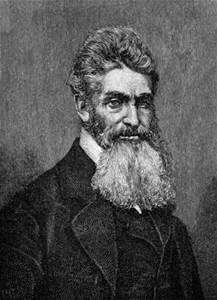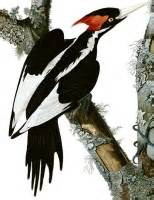I delight in reading about the ivory bill woodpecker and pine to see one in flight or hammering away. Unfortunately, they’re evidently extinct, according to all but the most optimistic lost-cause birders. Fortunately, however, a pair of pileated woodpeckers – similar in silhouette but smaller, less musical and different in coloring from their vanished cousins – haunt the woods I live in. I keep my eye peeled for them and discovered last year that two juveniles were foraging in the area as well. When I want to inquire deeper into matters ornithological, I go to a source like The Race to Save the Lord God Bird by Phillip Hoose, Tim Gallagher’s The Grail Bird or Michael K. Steinberg’s Stalking the Ghost Bird. There’s a good but desperately hopeful documentary film about possible Arkansas survivors, too. (And I wonder why my bookshelves runneth over. . . .)
 That rarum avis (and zealot and rebel, liberator, charismatic terrorist) John Brown has long fascinated me, as well, and about two decades ago I served for two months as the first (maybe only, as it turns out) writer-in-residence at the Harper’s Ferry National Historical Park. I read Robert Penn Warren’s John Brown: The Making of a Martyr while I was there, along with Stephen B. Oates’s hagiographic To Purge this Land with Blood (which is more admiring of Brown than I can be) and was on hand to examine (with gloves) a newly-loaned artifact for display, the Sharps carbine Brown probably carried during his quixotic (but in some ways right-minded) raid on the Federal arsenal as HF. I studied the landscape, the maps, the artifacts, the various accounts in books and on park videos. I spent afternoons at the Kennedy Farm (nearby lurk headquarters) across the river in MD and even made a cobbler from fruit (both dark purple and white) off the mulberry trees there. I had already read Russell Banks’ brilliant (and again, admiring of the subject) Cloudsplitter, as powerful a historical novel as I know, and followed the fictional account that presented Brown as a hybrid bred from Moses, Ahab, one dupe and maybe three demons, while still painting him as a real and inevitable, if infuriating, man. Needless to say, I hated to leave that haunted corner of W. VA. when my time there expired, and I left with all my senses and inquiries sharpened..
That rarum avis (and zealot and rebel, liberator, charismatic terrorist) John Brown has long fascinated me, as well, and about two decades ago I served for two months as the first (maybe only, as it turns out) writer-in-residence at the Harper’s Ferry National Historical Park. I read Robert Penn Warren’s John Brown: The Making of a Martyr while I was there, along with Stephen B. Oates’s hagiographic To Purge this Land with Blood (which is more admiring of Brown than I can be) and was on hand to examine (with gloves) a newly-loaned artifact for display, the Sharps carbine Brown probably carried during his quixotic (but in some ways right-minded) raid on the Federal arsenal as HF. I studied the landscape, the maps, the artifacts, the various accounts in books and on park videos. I spent afternoons at the Kennedy Farm (nearby lurk headquarters) across the river in MD and even made a cobbler from fruit (both dark purple and white) off the mulberry trees there. I had already read Russell Banks’ brilliant (and again, admiring of the subject) Cloudsplitter, as powerful a historical novel as I know, and followed the fictional account that presented Brown as a hybrid bred from Moses, Ahab, one dupe and maybe three demons, while still painting him as a real and inevitable, if infuriating, man. Needless to say, I hated to leave that haunted corner of W. VA. when my time there expired, and I left with all my senses and inquiries sharpened..
Where is this headed? Oh ye of little faith. . . .
When I saw in 2013 that James McBride had written a novel entitled The Good Lord Bird and that it was about John Brown, I couldn’t believe my luck. Salt-cured ham and sweet potato on the same plate! So I ordered a copy and, true to form, swiftly misplaced it. Well, as Frostian way leads on to way, I followed the distraction trail to dabble in and read other things, while the book received kudos and McBride collected his National Book Award. My memory serves no master, so the book’s existence melted like ice in July. But then, serendipity, I stumbled upon another reference to the book and recovered my resolve to read it, despite my commitment to a summer of Patricia Highsmith novels and stories. And luck was with me: for some reason – probably that NBA – our college library had a copy, which was available.
The timing was right. Just three years since the acclaimed film of Twelve Years a Slave threw the spotlight on the original (if ghostwritten) book, a year since Tom Piazza’s challenging novel A Free State explored ante-bellum identity through a mixed race runaway eluding capture while masquerading as a very dark African while playing exhilarating banjo in a minstrel show. And this summer we have a new Roots miniseries. Add these to Banks’ established and provocative Cloudsplitter and William Styron’s much-debated Confessions of Nat Turner, and you have an exciting and controversial literary landscape of historical novels on similar subjects, many of them thriving under the vast canopy of Huckleberry Finn. But none of them have the ivory bill.
 Nor does McBride’s book very much have the bird, though feathers materialize and are brandished on occasion. And it’s not likely to become a movie, because it’s a novel about narrative voice as much as anything else, and MacBride gallops in where angels fear to tread on the matter of whether or not to use language that is authentically offensive or offensively authentic. In the current political/rhetorical climate in which book banners are sour because book BURNING has been given such a bad name, McBride weighs in on the side of offensive language but with a tactical mind. He out-offends anything Twain’s wife would let him write, but he does it with high and low, outrageous mischief, The Good Lord Bird being a rollicking, twisted discourse on obscenity, grittiness, ultra-violence and insanity, all wrapped in a historical blanket. I won’t say it makes David Milch’s HBO Deadwood look tame, but that series appears less radical in juxtaposition to McBride’s Brown/bird/cross-dressing (yes, Caitlin’s transformation is almost anticipated) gallimaufry.
Nor does McBride’s book very much have the bird, though feathers materialize and are brandished on occasion. And it’s not likely to become a movie, because it’s a novel about narrative voice as much as anything else, and MacBride gallops in where angels fear to tread on the matter of whether or not to use language that is authentically offensive or offensively authentic. In the current political/rhetorical climate in which book banners are sour because book BURNING has been given such a bad name, McBride weighs in on the side of offensive language but with a tactical mind. He out-offends anything Twain’s wife would let him write, but he does it with high and low, outrageous mischief, The Good Lord Bird being a rollicking, twisted discourse on obscenity, grittiness, ultra-violence and insanity, all wrapped in a historical blanket. I won’t say it makes David Milch’s HBO Deadwood look tame, but that series appears less radical in juxtaposition to McBride’s Brown/bird/cross-dressing (yes, Caitlin’s transformation is almost anticipated) gallimaufry.
So the stage is set, but do I recommend McBride’s novel, which is presented as a long-lost document narrated or written by a former slave who lives to be a hundred (shades of Berger’s Jack Crabbe)? It’s certainly an ambitious book with pleasures and frustrations to offer, but for my conflicted and enigmatic scorecard will have to wait for the next post. I’ll try not to be away too long. Stay tuned.
[P.S. If you want something to do in the meantime, I recommend The Life and Letters of Captain John Brown, edited by Richard Webb and published in London in 1861. The book was re-issued by Negro Universities Press in 1972, and there’s a copy of the original edition in the Duke University Library.]

